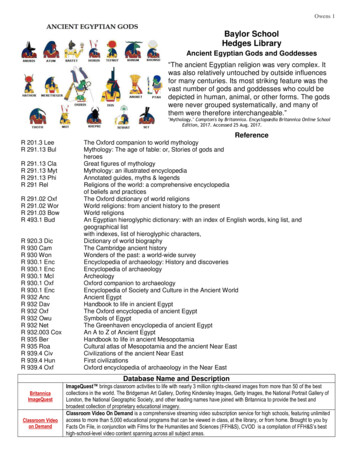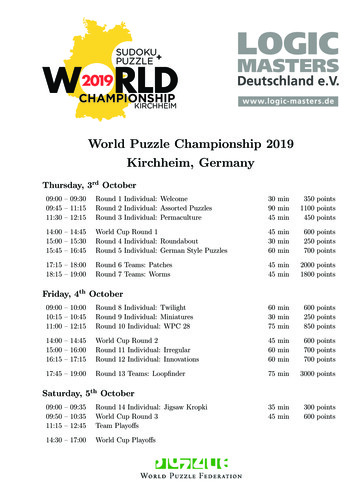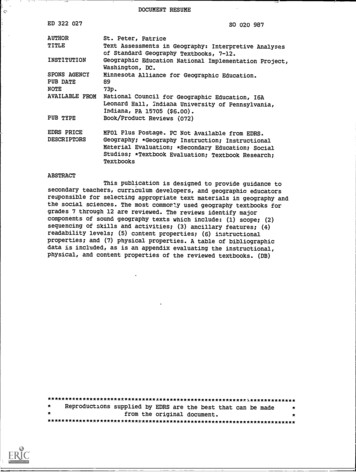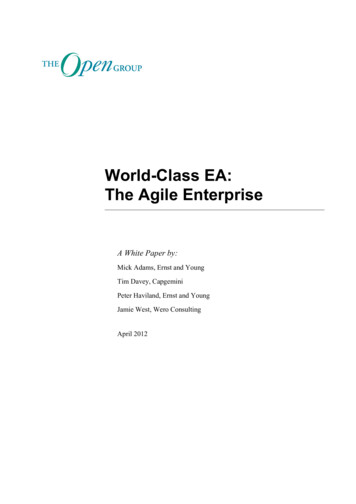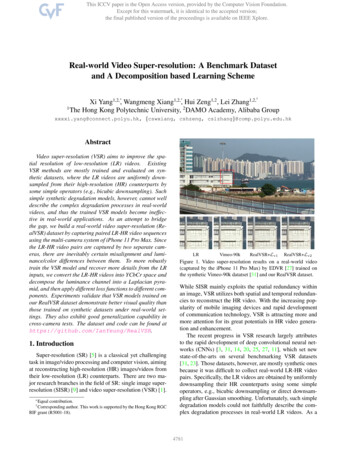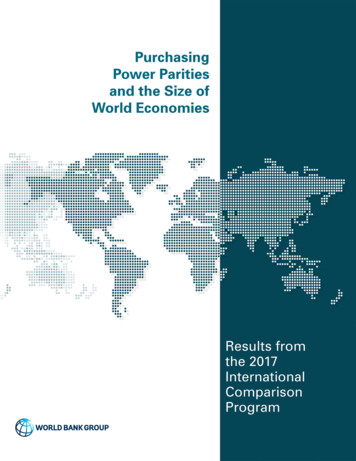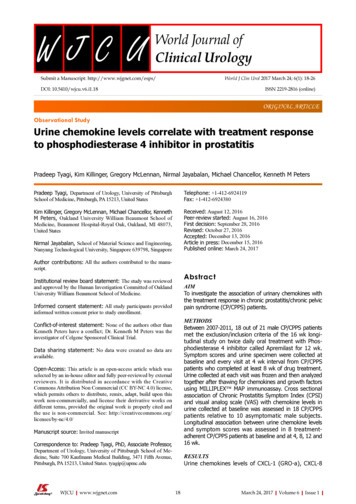
Transcription
WJC UWorld Journal ofClinical UrologyWorld J Clin Urol 2017 March 24; 6(1): 18-26Submit a Manuscript: http://www.wjgnet.com/esps/DOI: 10.5410/wjcu.v6.i1.18ISSN 2219-2816 (online)ORIGINAL ARTICLEObservational StudyUrine chemokine levels correlate with treatment responseto phosphodiesterase 4 inhibitor in prostatitisPradeep Tyagi, Kim Killinger, Gregory McLennan, Nirmal Jayabalan, Michael Chancellor, Kenneth M PetersPradeep Tyagi, Department of Urology, University of PittsburghSchool of Medicine, Pittsburgh, PA 15213, United StatesTelephone: 1-412-6924119Fax: 1-412-6924380Kim Killinger, Gregory McLennan, Michael Chancellor, KennethM Peters, Oakland University William Beaumont School ofMedicine, Beaumont Hospital-Royal Oak, Oakland, MI 48073,United StatesReceived: August 12, 2016Peer-review started: August 16, 2016First decision: September 28, 2016Revised: October 27, 2016Accepted: December 13, 2016Article in press: December 15, 2016Published online: March 24, 2017Nirmal Jayabalan, School of Material Science and Engineering,Nanyang Technological University, Singapore 639798, SingaporeAuthor contributions: All the authors contributed to the manu script.AbstractInstitutional review board statement: The study was reviewedand approved by the Human Investigation Committed of OaklandUniversity William Beaumont School of Medicine.AIMTo investigate the association of urinary chemokines withthe treatment response in chronic prostatitis/chronic pelvicpain syndrome (CP/CPPS) patients.Informed consent statement: All study participants providedinformed written consent prior to study enrollment.METHODSBetween 2007-2011, 18 out of 21 male CP/CPPS patientsmet the exclusion/inclusion criteria of the 16 wk longi tudinal study on twice daily oral treatment with Phos phodiesterase 4 inhibitor called Apremilast for 12 wk.Symptom scores and urine specimen were collected atbaseline and every visit at 4 wk interval from CP/CPPSpatients who completed at least 8 wk of drug treatment.Urine collected at each visit was frozen and then analyzedtogether after thawing for chemokines and growth factorsusing MILLIPLEX MAP immunoassay. Cross sectionalassociation of Chronic Prostatitis Symptom Index (CPSI)and visual analog scale (VAS) with chemokine levels inurine collected at baseline was assessed in 18 CP/CPPSpatients relative to 10 asymptomatic male subjects.Longitudinal association between urine chemokine levelsand symptom scores was assessed in 8 treatmentadherent CP/CPPS patients at baseline and at 4, 8, 12 and16 wk.Conflict-of-interest statement: None of the authors other thanKenneth Peters have a conflict; Dr. Kenneth M Peters was theinvestigator of Celgene Sponsored Clinical Trial.Data sharing statement: No data were created no data areavailable.Open-Access: This article is an open-access article which wasselected by an in-house editor and fully peer-reviewed by externalreviewers. It is distributed in accordance with the CreativeCommons Attribution Non Commercial (CC BY-NC 4.0) license,which permits others to distribute, remix, adapt, build upon thiswork non-commercially, and license their derivative works ondifferent terms, provided the original work is properly cited andthe use is non-commercial. See: script source: Invited manuscriptCorrespondence to: Pradeep Tyagi, PhD, Associate Professor,Department of Urology, University of Pittsburgh School of Me dicine, Suite 700 Kaufmann Medical Building, 3471 Fifth Avenue,Pittsburgh, PA 15213, United States. tyagip@upmc.eduWJCU www.wjgnet.comRESULTSUrine chemokines levels of CXCL-1 (GRO-a), CXCL-818March 24, 2017 Volume 6 Issue 1
Tyagi P et al . Urine chemokines in prostatitis(IL-8), CXCL-10 (IP-10) and CCL5 (RANTES) in CP/CPPSpatients at baseline were significantly elevated relative toasymptomatic subjects, whereas levels of sIL-1RA in CP/CPPS were significantly lower compared to controls (P 0.05). Quantitatively, urine levels of CXCL-10 were higherthan other chemokines in CP/CPPS, but its fold change of5 relative to controls was lower than the 20 fold changenoted for CXCL-8. The mean age of enrolled patients whocompleted at least 8 wk of treatment (n 8) was 46.5 9.4 years and analysis found that elevation of CXCL-8and CCL5 increased the odds for higher score of CPSI by54% and 25%, respectively (F test, P 0.00007). Urinelevels of CCL2 (MCP-1) and CXCL-10 together explainedapproximately 85% of variance in longitudinal data onmultivariate analysis. Bivariate analysis of 5 patients whofully complied and completed the assigned dose regimen,showed strong linear correlation of reduced urinelevels of CXCL-10, CXCL-8, CCL5, CCL2 and PDGF withimprovement in clinical activity as measured by pain VASand CPSI (Pearson r 0.83-0.97; P 0.05).(CPPS) is a poorly understood and prevalent male con dition that affects 10% to 14% of men of all ages and[1]ethnic origins . According to the National Institutes ofHealth (NIH) consensus definition, CPPS is regarded ascategory Ⅲ prostatitis described by genital or pelvic painin the absence of demonstrable urinary or genital tract[2]infection .Unlike NIH categoryⅠand Ⅱ prostatitis, the patho physiology of category Ⅲ (CP/CPPS) is an enigma andmay not be as organ (prostate) centric as categoriesⅠand[2]Ⅱ . With progression of symptom severity, CP/CPPSmay evolve into regional pain syndrome with symptoms[3]resembling interstitial cystitis . Considering the signi ficant inflammatory component in CP/CPPS, most prior[4]therapies have focused on targeting inflammation .Leukocyte infiltration is a primary event in inflammationand because expression of chemokines temporally[5]precede that it makes the chemokines well suited to[6]serve as biomarkers for pelvic pain disorders .Interestingly, leukocytes and immune cells pre dominantly express a cyclic adenosine mono phosphatecAMP metabolizing isoenzyme called phosphodiesterase[7]4 (PDE4) . Consequently, selective pharmacologicalinhibition of PDE4 by Apremilast, a novel, orally availablesmall molecule, can cause buildup of cAMP which affectsproduction of cytokines including CXCL-10 (IP-10),CCL2/monocyte chemoattractant protein-1 (MCP-1),CCL5/Regulated on Activation, Normal T cell Expressedand Secreted (RANTES) and vascular endothelial growth[8]factor (VEGF) . Since mechanism of action for Apremilastis different from traditional anti-inflammatory drugs (NSAIDS), it could have potential efficacy in CP/CPPS patients[9]refractory NSAIDS , which work by inhibiting COX insteadof PDE4.Previous studies have reported correlations betweenincreased cytokines, chemokines and growth factors inthe semen and prostatic secretions with symptom scores[10,11]of CP/CPPS. Instead of seminal plasma, we aimedto correlate in a longitudinal study the disease severityand treatment response to Apremilast by non-invasivemeasurement of chemokines in urine of CP/CPPS pa tients.CONCLUSIONUrine levels of CXCL-10, CCL2 and PDGF can be sensitive,objective and non-invasive markers of response to newtherapeutic intervention in CP/CPPS patients.Key words: Chronic prostatitis; Longitudinal measurement;Phosphodiesterase 4; Urine; Chronic pelvic pain syndrome;Chemokines The Author(s) 2017. Published by Baishideng PublishingGroup Inc. All rights reserved.Core tip: Chronic prostatitis or chronic pelvic pain syn drome is a poorly understood and prevalent male con dition, which is generally described by pelvic pain in theabsence of demonstrable urinary or genital tract infection.Inflammation is considered to play a critical role in theprostatitis and so we carried out a small physician initiatedclinical study to investigate the potential efficacy of a newphosphodiesterase 4 inhibitor drug, Apremilast. Urinewas collected from the study participants at the baselineand at each visit to assay the chemokine levels and thendetermine their association with the treatment response.We are the first to report that chemokine levels in urineinstead of the semen or prostatic secretions have thepotential to serve as non-invasive biomarkers of severityand treatment response of the prostatitis patients.MATERIALS AND METHODSPatient selectionAdult male subjects aged 18 years at time of informedconsent were recruited in a prospective open-label, one[9]arm, physician initiated study (NCT00701311) that wasapproved by the institutional review board (HIC-2007-135).The inclusion and exclusion criteria for CP/CPPS patientsenrolled in a 12 wk oral therapy of PDE4 inhibitor,Apremilast (20 mg BID; provided by Celgene), can also befound at http://clinicaltrials.gov/ct2/show/NCT00701311.The inclusion criteria were patients with clinical symptomsof CP/CPPS (pain in the pelvic area, penis, scrotum, orperineum) who were refractory to other therapies (e.g.,NSAIDS) for at least 3 of the 6 mo immediately before thefirst visit. Enrolled patients also fulfilled the NIH definitionof CP/CPPS (category Ⅲ prostatitis) and had a NIH-CPSITyagi P, Killinger K, McLennan G, Jayabalan N, ChancellorM, Peters KM. Urine chemokine levels correlate with treatmentresponse to phosphodiesterase 4 inhibitor in prostatitis. World JClin Urol 2017; 6(1): 18-26 Available from: URL: http://www.wjgnet.com/2219-2816/full/v6/i1/18.htm DOI: NChronic prostatitis (CP) or chronic pelvic pain syndromeWJCU www.wjgnet.com19March 24, 2017 Volume 6 Issue 1
Tyagi P et al . Urine chemokines in prostatitistotal score of 15 or higher. Exclusion criteria were subjectswith genital infection, clinical epididymitis, documentedpositive urine culture ( 100000 CFU/mL) within thepast three months, pelvic mass, or known active or priorgenitourinary malignancies (including renal, ureteral,bladder or prostate). Urine samples from 10 age-matchedmales without CP/CPPS diagnosis or symptoms were alsoincluded as controls in the analysis for comparison.conjunction with the other variables using Unscrambler X 10.1 software (CAMO Software Inc, NJ, United States).Assumptions of linearity were verified for each modeland age, urine chemokines, and duration of CP/CPPSsymptoms were included as covariates in all models.Pearson (r) and Spearman (rs) correlation test were usedto assess the correlations among reductions in urinarychemokines and clinical out comes. All statistical tests wereevaluated for statistical significance at α 0.05 2-tailed,and trends at 0.05 α 0.10. Continuous variables areexpressed as mean standard error of mean.Follow up protocolClinical and laboratory assessments were performed atbaseline and then every 4 wk till the end of treatment(at 12 wk) with a final follow up at week 16. Clinicalassessment for improvement in symptoms after treat ment included change between week 0 and week 12 inthe chronic prostatitis symptom index (CPSI), which is avalidated urinary and pain measurement tool from theNIH. Pain was measured using a visual analog scale (VAS)for pain (0 no pain and 10 worst pain imaginable).Laboratory assays included urine culture at baseline,complete blood count, metabolic blood chemistry, uri nalysis, liver and kidney function tests, and PSA.RESULTSBaseline clinical and demographics featuresOf the 21 patients recruited for the study only 18 metthe exclusion/inclusion criteria and provided urine atbaseline, 7 provided a urine specimen at baseline but didnot complete at least 8 wk of treatment, and 3 otherswithdrew before completing the study. The mean ageof enrolled patients who completed at least 8 wk oftreatment (n 8) was 46.5 9.4 years. Among 8 CP/CPPS patients, those who fully complied and completedthe assigned dose regimen are referred to as treatmentadherent (n 5) and those not completely adherent toregimen are referred to as treatment non-adherent CP/CPPS patients (n 3).SpecimensUrine specimens were collected from consented patientsat baseline and at 4, 8, 12 and 16 wk after startedtreatment. Urine dipstick was done after each urinecollection. After collection, all the spot-urine sampleswere frozen at -80 until analysis.Urine levels of chemokines in CP/CPPS and controlsUrine dipstick done after each collection ruled out pre sence of urinary infection. At baseline, levels of CX CL-1(15 fold), CXCL-8 (20 fold) and CXCL-10 (5 fold) weresignificantly elevated in CP/CPPS (P 0.05) (Figure 1A-C).Higher levels of CXCL-10 (169.8 46.38 pg/mL vs 31.45 16.83 pg/mL) relative to controls is in agreement withthe intra-acinar infiltration of T-lymphocytes previously[12]noted in prostate biopsy of CP/CPPS patients . Levelsof neutrophil attracting CXC chemokines CXCL-1 (32.46 9.9 pg/mL) and CXCL-8 (5.3 1.8 pg/mL) were[12]comparatively lower in CP/CPPS (notice scale on Y-axisFigure 1).CCL5, which is also known to drive trafficking of lym [13]phocytes(Figure 1E), was also significantly elevatedin CP/CPPS relative to controls (19.26 6.8 pg/mL vs0.14 0.02 pg/mL). CCL2 and PDGF were detectedin substantial amount in all the CP/CPPS patients, butdue to high variability in the control group, results werenot significant (Figure 1D and F, respectively). Levelsof CXCL-1, CXCL-8 and CCL5 in the control group wereuniformly below or very near the detection limit of ourassay method.Urine levels of CXCL-8 and CCL5 levels were not onlyquantitatively lower in CP/CPPS patients compared toother chemokines (Figure 1), but were also detected onlyin 7 and 8 patients, respectively, of 18 enrolled CP/CPPSpatients at baseline. The urine levels of CXCL-1, CXCL-8and CCL5 in the control group were uniformly belowor very near the detection limit of our assay method.Assay of urinary chemokinesOn the day of analysis, all the frozen urine samples werethawed quickly and nine different chemokines/cytokinesin urine were measured by MILLIPLEX human cytokine/chemokine immunoassay following the procedure as pre [6]viously described . An automated immu noassay analyzerBioplex Luminex 200 IS System, (Luminex, Austin, TX)purchased through Bio-Rad, was used to assay chemokinesusing commercially available microspheres (Millipore,Billerica, MA) following manufacturer’s instru ctions.Microspheres of defined spectral properties con jugatedto antibody directed against CXCL-1, CXCL-8, CXCL-10,IL-6, soluble interleukin-1 receptor antagonist (sIL-1RA),MCP-1 (CCL2), RANTES (CCL5), VEGF, platelet derivedgrowth factor (PDGF) were pipetted into 96-well plate. Themedian fluorescence intensity of microspheres specific foreach chemokine was recorded for each well to calculatechemokine concentration.Statistical analysisThe differences in urine levels of chemokines betweencontrols and CP/CPPS patients were measured by MannWhitney U test. The test assesses significant differencesbetween groups without making assumptions of nor mality.Both bivariate and multivariate models using prin cipalcomponent analysis (PCA) were examined to assess thedegree to which each baseline predictor was associatedwith the clinical outcome measures independently or inWJCU www.wjgnet.com20March 24, 2017 Volume 6 Issue 1
200100CXCL-1B50pg/mLApg/mLTyagi P et al . Urine chemokines in prostatitis25CXCL-8a800400Control0CP/CPPSControlD 00200a0ControlCP/CPPSFigure 1 Comparative baseline levels of cytokines, CXC and CC chemokines and growth factors in urine obtained from asymptomatic individuals andchronic prostatitis/chronic pelvic pain syndrome patients. A-C: Urine levels of CXCL-1, CXCL-8 and CXCL-10 chemokines at baseline were significantly elevatedin CP/CPPS patients (aP 0.05). Quantitatively, levels of CXCL-10 (169.8 46.38 pg/mL vs 31.45 16.83 pg/mL) that attract lymphocytes were higher relative to otherCXC chemokines CXCL-1 and CXCL-8 that attract neutrophils (notice scale on y-axis). Levels of CC chemokine, CCL-5 (RANTES) also chemotactic for lymphocytes(E) were significantly elevated in CP/CPPS relative to controls (aP 0.05). Lymphocytic infiltration previously noted in biopsy of CP/CPPS patients is also consistent withsignificantly lower levels of sIL-1RA in CP/CPPS (G) compared to controls (aP 0.05). Due to high variability in control group, results were not significant with respect toCCL2 and PDGF (D and F, respectively). Horizontal bars represent mean of the group and Mann-Whitney U test was used for unpaired comparison and chemokines withsignificant difference appear in bold. CP/CPPS: Chronic prostatitis/ronic pelvic pain syndrome; sIL-1RA: Soluble interleukin-1 receptor antagonist.WJCU www.wjgnet.com21March 24, 2017 Volume 6 Issue 1
Tyagi P et al . Urine chemokines in prostatitis300PC-2 3Loadings0.8CXCL-10200C4BScores16s21sPC-2 300-5000500100015000.00.20.4PC-1 (76%)C50021v521sDScores4001.0CXCL-1016s200PC-2 (16%)PC-2 (16%)0.80.83001000.6PC-1 -1000.0-200-300-50005001000-0.2-0.21500PC-1 (76%)CCL20.00.20.40.60.81.0PC-1 (76%)Figure 2 Visualization of principal component analysis principal component analysis for the cross sectional data of asymptomatic controls (C1-10)and chronic prostatitis/chronic pelvic pain syndrome patients (1 s-21 s). At baseline (A and B) and the longitudinal treatment response data of adherent andnon-adherent CP/CPPS patients (C and D), PC1 and PC2 explained 76 % and 9% of the data characteristics at baseline (A and B), respectively which in turn wasexplained largely by the variation in the urine levels of CCL2, CXCL-10 and PDGF. Majority of CP/CPPS mapped separately from a close cluster for controls (A), andthe spreading of CP/CPPS is explained by disease heterogeneity as revealed by the variation in the levels of different chemokines in CP/CPPS at baseline (Figure 1).PCA of longitudinal data also included VAS and CPSI scores measured at each visit as variables, where each dot represents the expression profile of an individualpatient at a singular timepoint identified by baseline (s), visit 5 (v5), visit7 (v7), visit 9 (v9), and final visit (v10) (C). PCA allowed grouping of patients with overall similarcytokine expression profiles at individual time points. Compared to PCA of cross-sectional data (A and B), the contribution of CCL2 was slightly increased whereascontribution of CXCL-10 was slightly reduced in PC1 of longitudinal data (Panel D). The urine levels of CXCL-1 and CCL5 together with CPSI scores only contributed 1% to both PC1 and PC2 scores. PC: Principal components; PDGF: Platelet derived growth factor.Significantly higher levels of sIL-1RA in controls relativeto CP/CPPS (Figure 1G) are consistent with its antiinflammatory role (P 0.05).PCA was used to reduce the dimensionality by extra cting two principal components (PCs), PC1 and PC2 fromthe cross-sectional data of 9 cytokines from 18 CP/CPPSpatients and 10 controls at baseline (Figure 2A and B).PC1 and PC2 together explain most of the variation, 76%and 9% respectively, and are defined by a weighted sumof the individual cytokine values referred to as loadings(Figure 2B). The majority of variance at baseline wasexplained by CCL2, CXCL-10 and PDGF. The value of PC1and PC2 for each patient and controls were calculated andthese values are referred to as “scores”. The scores arerepresented graphically to summarize the variation (Figure2A). The majority of CP/CPPS mapped separately fromcontrols, but a close cluster of CP/CPPS patients like mostcontrols was absent which can be explained by diseaseheterogeneity as revealed by the variation in the levels ofWJCU www.wjgnet.comdifferent chemokines in CP/CPPS at baseline (Figure 1).Correlation of urinary chemokines with clinicaloutcomesSignificant improvement in clinical outcome measures(VAS and CPSI) was noted post treatment in adherentCP/CPPS patients (Figure 3). Multivariate modeling ofdata from treatment adherent and non-adherent patientstogether (n 8) revealed that age and duration ofCP/CPPS symptoms had no effect on the CPSI or VASscores or on the response to treatment. The longitudinaleffect of treatment was visualized by PCA (Figure2C) after excluding the data of Patient 6 due to highvariation relative to other treated CP/CPPS patients. PCAallowed grouping of patients with overall similar cytokineexpression profiles at individual time points. With regardto cross-sectional data (Figure 2A and B), the contributionof CCL2 was slightly increased whereas contribution ofCXCL-10 was slightly reduced in PC1. CXCL-1, CCL5 and22March 24, 2017 Volume 6 Issue 1
Tyagi P et al . Urine chemokines in prostatitisA1000BPatient 1010000Patient L-10.1C 10000100016kWee12Week8k4kWeeBaDPatient 6Weelinese16Week12Week8Week4kWeeBaseline0.1Patient e8kWee4kWeeBaseline1Patient GF16Week12Week8Week4WeekBaseline1Figure 3 Significant improvement in clinical outcome measures was noted post treatment in adherent chronic prostatitis/chronic pelvic pain syndromepatients. A-E: The disease heterogeneity and variability in response to treatment in CP/CPPS patients is highlighted by different urinary chemokines correlating withthe clinical outcome scores measured at each visit (VAS and CPSI) in different treatment adherent Patients 6, 9, 10, 16 and 17 at baseline and week 4, 8, 12 and16 after starting treatment. Lower VAS in Patient 10 strongly correlated with reduced urine levels of CXCL-10 (triangle; Pearson r 0.97; P 0.003), CCL2 (Invertedtriangle; r 0.97; P 0.005), CCL5 (diamond; r 0.99; P 0.0001), VEGF (square; r 0.98; P 0.003) and PDGF (circular; r 0.99; P 0.0001) at various timepoints and CPSI scores correlated with CXCL-10 (triangle; Pearson r 0.96; P 0.009), CCL2 (Inverted triangle; r 0.86; P 0.05), CCL 5 (diamond; r 0.91; P 0.03),VEGF (square; r 0.80; P 0.1), PDGF (circular; r 0.86; P 0.06) and CXCL-1 (rs 0.9; P 0.08) (A). In contrast, in Patient 17, only VAS scores showed strongcorrelation with CXCL-10 (triangle) (Pearson r 0.84; P 0.07), IL-8 (triangle) (r 0.94; P 0.01) and sIL-1RA (square) (r 82; P 0.08) (B) and CPSI showedSpearman rs coefficient of 0.4-0.5 for PDGF, CXCL-10 and CXCL-8 without any significance. In Patient 6 (C), reduced CXCL-10 (triangle) strongly correlated withlower VAS (r 0.89; P 0.04) and CPSI (r 0.82; P 0.08) and PDGF (circular) correlated with VAS (rs 0.89; P 0.08) and CPSI (rs 0.9; P 0.08). In Patient 9 (D),lower CCL5 (diamond) strongly correlated VAS (r 0.80; P 0.09) and CPSI (r 0.86; P 0.05) whereas CCL2 (Inverted triangle) correlated only with VAS (rs 0.9;P 0.08). In Patient 16 (E), PDGF (circular) correlated with VAS (r 0.95; P 0.01) and CPSI correlated with CXCL-10 (triangle) (rs 0.82; P 0.13) Notice the logscale on the y-axis in all the panels. The units of pg/mL only apply to chemokines and not to VAS and CPSI scores. PDGF: Platelet derived growth factor; VAS: Visualanalog scale; CPSI: Chronic Prostatitis Symptom Index; IL: Interleukin; VEGF: Vascular endothelial growth factor.WJCU www.wjgnet.com23March 24, 2017 Volume 6 Issue 1
Tyagi P et al . Urine chemokines in prostatitisCPSI scores together contributed 1% to both PC1 andPC2 scores. Furthermore, the elevated CXCL-8 and CCL5raised the odds ratio for higher CPSI scores by 54% and25%, respectively (F test, P 0.00007).Considering the variability of treatment response,we used both parametric and non-parametric bivariatecorrelation analysis for clinical outcome scores measuredat each visit with the respective urine levels of chemokinesindividually for each of the 5 treatment adherent patients(Figure 3). Analysis of longitudinal data from treatmentadherent Patient 10 (Figure 3A) demonstrated that lowerVAS strongly correlated with reduced levels of CXCL-10(Pearson r 0.97; P 0.003), CCL2 (r 0.97; P 0.005),CCL5 (r 0.99; P 0.0001), VEGF (r 0.98; P 0.003)and PDGF (r 0.99; P 0.0001). Lower CPSI alsocorrelated with reduced levels of CXCL-10 (r 0.96; P 0.009), CCL2 (r 0.86; P 0.05), CCL5 (r 0.91; P 0.03), VEGF (r 0.80; P 0.1), PDGF (r 0.86; P 0.06)and CXCL-1 (rs 0.9; P 0.08). In contrast, only the VASof Patient 17 (Figure 3B) strongly correlated with CXCL-10(r 0.84; P 0.07), CXCL-8 (r 0.94; P 0.01) and sIL1RA (r 82; P 0.08) and CPSI showed rs coefficient of0.4-0.5 for PDGF, CXCL-10 and CXCL-8 without achievingstatistical significance.In Patient 6 (Figure 3C), reduced CXCL-10 stronglycorrelated with VAS (r 0.89; P 0.04) and CPSI (r 0.82; P 0.08) and PDGF correlated with VAS (rs 0.89;P 0.08) and CPSI (rs 0.9; P 0.08). For Patient 9(Figure 3D), lower CCL5 strongly correlated with VAS (r 0.80; P 0.09) and CPSI (r 0.86; P 0.05), andCCL2 correlated only with VAS (rs 0.9; P 0.08). InPatient 16 (Figure 3E) PDGF correlated with VAS (r 0.95; P 0.01) and CPSI correlated with CXCL-10 (rs 0.82; P 0.13).levels of different chemokines at baseline (Figure 1) anddifferent chemokines correlating with treatment inducedreduction in VAS and CPSI scores in different patients(Figure 3). The disease heterogeneity and variability intreatment response of CP/CPPS patients justify the need forpersonalized treatment guided by urinary biomarkers.[17]CCL2 previously detected in seminal plasmacanalso be non-invasively measured in urine (Figure 1D).Loading plots of cross-sectional and longitudinal dataidentified CCL2 as the key variable explaining the variancein data (Figure 2). CCL2, together with significant elevationof another CC chemokine (CCL5) in CP/CPPS (Figure 1E),agrees with previous suggestions of a do minant T-helper[19]Th1-mediated inflammation in CP/CPPS . Previouslyobserved activated T-lymphocytes in prostate biopsy[12]of CP/CPPS patientsalso supports Th1-mediatedinflammation and concurs with the results of our studythat showed higher urine levels of CXCL-10 (Figure 1C)[14]that chemoattracts activated T-lymphocytesrelativeto CXCL-1 and CXCL-8 (Figure 1A and B) that attract[20]neutrophils . CXCL-10 is induced by pro-inflammatoryinterferfon-γ (IFN-γ) or TNF-α directly or through activation[20]of nuclear factor-κB (NF-κB)and it chemoattracts Tcells, which inhibit the proliferation of endothelial cells and[21]inflammatory angiogenesis . Since sIL-1RA is known to[22]block T lymphocyte activation , the significantly lowerlevels of sIL-1RA (Figure 1G) in urine of CP/CPPS relativeto controls (P 0.05) also supports predominance ofT-lymphocytes in the pathophysiology of CP/CPPS.Interestingly, the same CCR5 receptor acted on byCCL2 and CCL5 for recruitment of macrophages, mono cytes and lymphocytes to inflammatory foci highlight the[23]inbuilt redundancy in chemokines signaling . Because[24]chemokines operate in integrated networks , a morecomplete understanding of their role can be gained bymeasuring multiple chemokines for examining patternsassociated with symptoms and prognosis of CP/CPPS. Theresults of our study and the statistical logic lend impetus tothe assertion that a multiple panel of chemokines instead[25]of single protein like PSA will be able to better serve asa “proteomic signature” to predict treatment response andstratify CP/CPPS patients according to disease severity.The predictive association of CXCL-8 and CCL5 withCPSI scores is corroborated by previous studies with[16]regard to CXCL-8 (IL-8)where CXCL-8 is known to[26]act as a secretagogue for histamine from basophils .Reduced levels of CXCL-8, CXCL-10, CCL2, CCL5, andPDGF measured individually in treatment adherentpatients strongly correlated with coincident lower VAS andCPSI scores (Figure 3). PCA analysis of longitudinal dataagree (Figure 2D) with regard to CXCL-10, and CCL2 is inagreement with the bivariate correlation of lower CXCL-10and CCL2 with lower VAS in Patients 6, 9, 10 and 17 (Figure3).The negative association of lower CXCL-10 and CCL2with pain scores of CP/CPPS is presumably linked to the[27]concentration dependent suppression of opioid receptors[28,29]and augmentation of TRPV1 receptor responsescaused by elevated chemokines. Drug related loweringDISCUSSIONIn our study, we focused on chemokines, which are mainlysubdivided into 2 families (CXC and CC) based on theposition and number of conserved cysteine as well as thepresence of intervening amino acid(s) between the first[14]two conserved cysteine residues . The CXC chemokines(CXCL-1, CXCL-8, CXCL-10) mainly act on neutrophilsand lymphocytes, while the CC chemokines (CCL2/MCP-1and CCL5/RANTES) act on monocytes and lymphocytes[14]without affecting neutrophils . Chemokines not onlyinduce chemotaxis but also activation of these target[15]cells in affected tissuethrough their influence on theexpression and/or affinity of leukocyte integrins to causeinflammatory cell adhesion and infiltration.A major finding of our clinical study is the successfulmeasurement of chemokines in urine of CP/CPPS patients,which have been previously detected only in seminal[16,17]plasma (CXCL-8 and CCL2). Previous longitudinalstudies on CP/CPPS only reported subjective symptom[18]scores , but we were able to correlate the subjectivescores with objective urine biomarker data. CP/CPPS, beinga chronic disease with substantial variation in symptoms[18]across patients , probably contributes to the variableWJCU www.wjgnet.com24March 24, 2017 Volume 6 Issue 1
Tyagi P et al . Urine chemokines in prostatitisof chemokines will unmask the endogenous pain killingeffect of opioid receptors and block the adverse effect ofafferents sensitization on pain to explain the lower painscores. The lower VAS and CPSI scores in Patients 6, 9,10, 16, 17
Pittsburgh, PA 15213, United States. tyagip@upmc.edu Telephone: 1-412-6924119 Fax: 1-412-6924380 Received: August 12, 2016 Peer-review started: August 16, 2016 First decision: September 28, 2016 Revised: October 27, 2016 Accepted: December 13, 2016 Article in press: December 15, 2016 Published online: March 24, 2017 Abstract AIM
